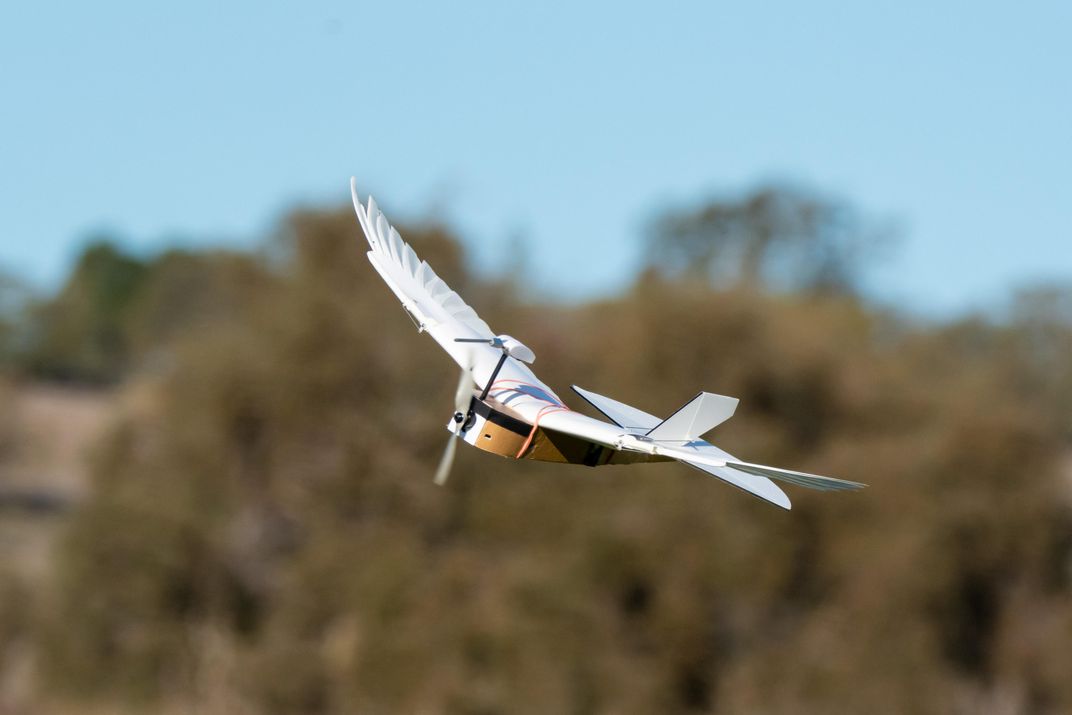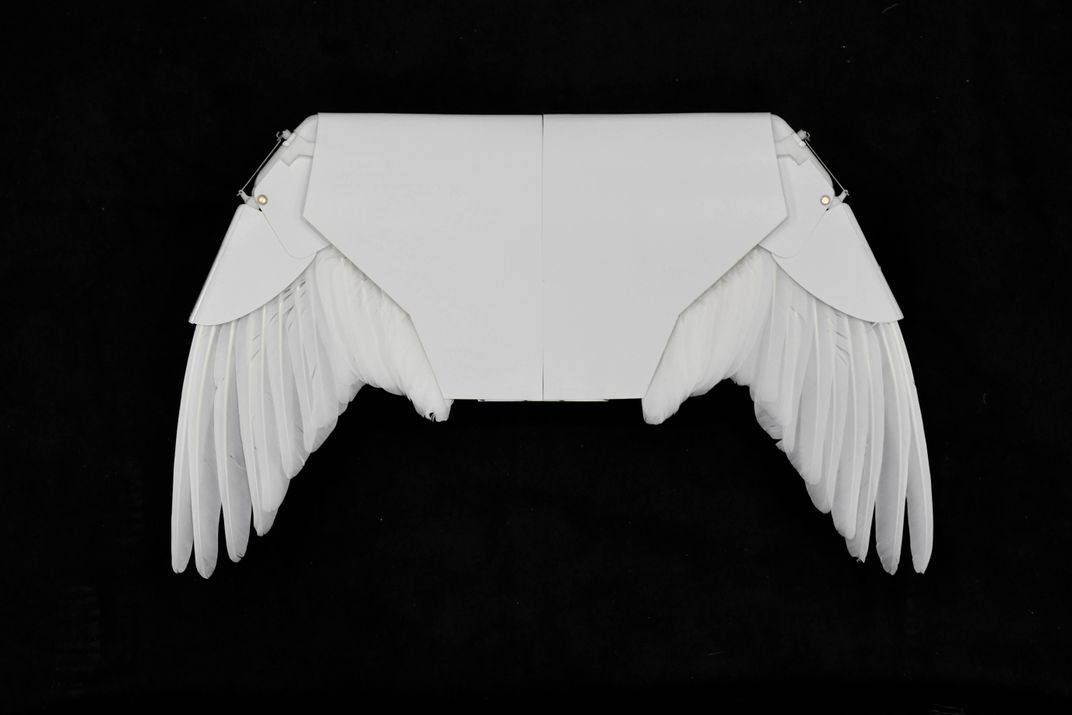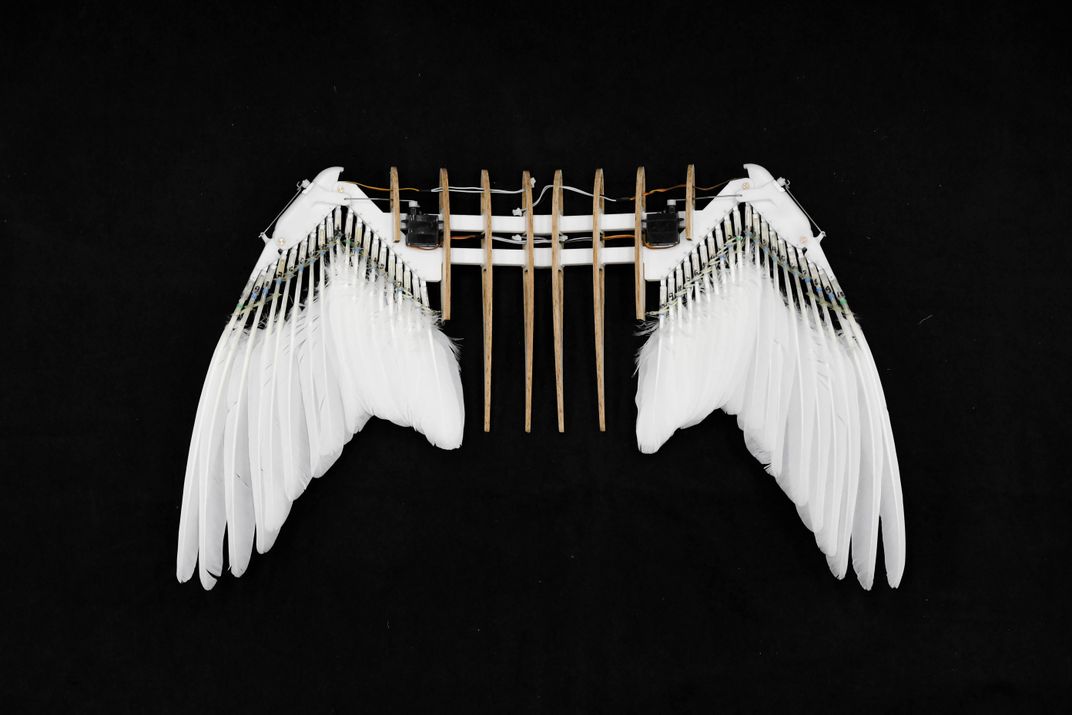‘PigeonBot’ Uses Real Feathers to Fly Like a Bird
The flying robot is better at following directions than its namesake
/https://tf-cmsv2-smithsonianmag-media.s3.amazonaws.com/filer/b3/cc/b3cc59d2-7c7b-432b-96b0-2507ebaed947/dl0_9515-2.jpg)
It’s a bird, it’s a plane, it’s… a bit of both. Meet PigeonBot, a biohybrid, flying robot that combines the propeller, fuselage, and tail of a man-made aircraft with the wing structure and actual feathers of a pigeon.
Designed by engineers at Stanford University, PigeonBot made its debut in a paper published on Thursday in Science Robotics. The bot can’t flap, but the mechanical skeleton has a few of the same joints as a bird’s wings. Bird wings are more complex, sharing a lot of anatomical features with human arms. For example, bird wings have features that resemble a human wrist and finger-like digit. PigeonBot has a wrist and finger, too, decked out with 40 feathers—20 per wing—gathered from domestic pigeons called squab, reports Rob Verger for Popular Science.
"Most aerospace engineers would say this is not going to work well, but it turned out to be incredibly robust," lead author David Lentink tells NPR’s Merrit Kennedy.
By programming the robot to bend at one joint, the researchers could see precisely how that movement contributes to a bird’s aeronautical maneuvers. While in the past, researchers wondered if each feather might be controlled by its own muscle, PigeonBot showed that adjusting the wrist or finger caused its feathers to fall into place.
“The problem is, of course, I don’t really know how to train a bird to just move its finger—and I actually am very good in bird training,” Lentink tells Maria Temming at Science News. “You can make manipulations in a robot wing that you could never do or want to do in a bird.”
The flying machine needed birdlike maintenance at times. If its feathers are ruffled, they need to be preened, or smoothed into place by hand, Lentink tells Popular Science. And the feathers work best together if they’re all sourced from the same bird.
The researchers flew the robot in a wind tunnel to see how the wings held together in different conditions. In turbulent winds, properly aligned feathers will hold themselves together with what Lentink calls “directional Velcro,” microscopic hooks that prevent the wing feathers from getting blown apart.
Lentink and his team worked with Smithsonian vertebrate zoologist Teresa Feo, who created nanometer-level 3-D reconstructions of the hooks and captured electron microscopy images to map their locations on different feathers for a separate paper published today in Science. By using PigeonBot, the researchers showed that the hooks were necessary for stable flight. When the feathers were rotated so the hooks couldn’t line up, they couldn’t hold together in strong gusts, and the bot became unstable. Like Velcro, the mechanism in feathers makes a noticeable sound, and it’s absent on silent fliers like barn owls.

"The work is very impressive," Alireza Ramezani, an Northeastern University engineer who led a team that built a bat-inspired robot in 2017, tells NPR.
Tyson Hendrick, a biomechanist at the University of North Carolina at Chapel Hill who was not involved in the study, tells Science News that Lentink’s PigeonBot the best set of robotic wings for testing birds’ wing feathers for flight, but “there’s plenty of room for improvement.” Hendrick notes the robot’s limited joints, and suggests that the effect of a shoulder joint to raise and lower the wings would be an interesting path for future research.
Ramezani sees the biology-inspired bot’s success as a path toward new drone designs and experimental aircraft, per NPR. Soft, feather-inspired designs would be safer to fly around people than the hard propellers of rotary drones. And Lentink suggests that the Velcro-like mechanism might be useful in high-tech clothing or specialized bandages. But feathered aircraft are probably not on the horizon.

